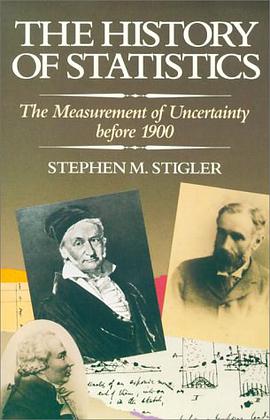The History of Statistics
豆瓣
The Measurement of Uncertainty before 1900
Stephen M. Stigler
简介
Review
Journal of Modern History : The book is a pleasure to read: the prose sparkles; the protagonists are vividly drawn; the illustrations are handsome and illuminating; the insights plentiful and sharp. This will remain the definitive work on the early development of mathematical statistics for some time to come.
--Lorraine J. Daston
Science : An exceptionally searching, almost loving, study of the relevant inspirations and aberrations of its principal characters James Bernoulli, de Moivre, Bayes, Laplace, Gauss, Quetelet, Lexis, Galton, Edgeworth, and Pearson, not neglecting a grand supporting cast...The definitive record of an intellectual Golden Age, an overoptimistic climb to a height not to be maintained.
--M. Stone
New York Times Book Review : One is tempted to say that the history of statistics in the nineteenth century will be associated with the name Stigler.
--Morris Kline
Contemporary Psychology : In this tour de force of careful scholarship, Stephen Stigler has laid bare the people, ideas, and events underlying the development of statistics...He has written an important and wonderful book...Sometimes Stigler's prose is so evocative it is almost poetic.
--Howard Wainer
Review
Stigler's book exhibits a rare combination of mastery of technical materials, sensitivity to conceptual milieu, and near exhaustive familiarity with primary sources. An exemplary study
--Lorraine Daston
contents
Introduction
I. The Development of Mathematical Statistics in Astronomy and Geodesy before 1827
1. Least Squares and the Combination of Observations
Legendre in 1805
Cotes’s Rule
Tobias Mayer and the Libration of the Moon
Saturn, Jupiter, and Euler
Laplace’s Rescue of the Solar System
Roger Boscovich and the Figure of the Earth
Laplace and the Method of Situation
Legendre and the Invention of Least Squares
2. Probabilists and the Measurement of Uncertainty
Jacob Bernoulli
De Moivre and the Expanded Binomial
Bernoulli’s Failure
De Moivre’s Approximation
De Moivre’s Deficiency
Simpson and Bayes
Simpson’s Crucial Step toward Error
A Bayesian Critique
3. Inverse Probability
Laplace and Inverse Probability
The Choice of Means
The Deduction of a Curve of Errors in 1772–1774
The Genesis of Inverse Probability
Laplace’s Memoirs of 1777–1781
The Error Curve of 1777
Bayes and the Binomial
Laplace the Analyst
Nonuniform Prior Distributions
The Central Limit Theorem
The Gauss–Laplace Synthesis
Gauss in 1809
Reenter Laplace
A Relative Maturity: Laplace and the Tides of the Atmosphere
The Situation in 1827
II. The Struggle to Extend a Calculus of Probabilities to the Social Sciences
5. Quetelet’s Two Attempts
The de Keverberg Dilemma
The Average Man
The Analysis of Conviction Rates
Poisson and the Law of Large Numbers
Poisson and Juries
Comte and Poinsot
Cournot’s Critique
The Hypothesis of Elementary Errors
The Fitting of Distributions: Quetelismus
6. Attempts to Revive the Binomial
Lexis and Binomial Dispersion
Arbuthnot and the Sex Ratio at Birth
Buckle and Campbell
The Dispersion of Series
Lexis’s Analysis and Interpretation
Why Lexis Failed
Lexian Dispersion after Lexis
7. Psychophysics as a Counterpoint
The Personal Equation
Fechner and the Method of Right and Wrong Cases
Ebbinghaus and Memory
III. A Breakthrough in Studies of Heredity
8. The English Breakthrough: Galton
Galton, Edgeworth, Pearson
Galton’s Hereditary Genius and the Statistical Scale
Conditions for Normality
The Quincunx and a Breakthrough
Reversion
Symmetric Studies of Stature
Data on Brothers
Estimating Variance Components
Galton’s Use of Regression
Correlation
9. The Next Generation: Edgeworth
The Critics’ Reactions to Galton’s Work
Pearson’s Initial Response
Francis Ysidro Edgeworth
Edgeworth’s Early Work in Statistics
The Link with Galton
Edgeworth, Regression, and Correlation
Estimating Correlation Coefficients
Edgeworth’s Theorem
10. Pearson and Yule
Pearson the Statistician
Skew Curves
The Pearson Family of Curves
Pearson versus Edgeworth
Pearson and Correlation
Yule, the Poor Law, and Least Squares: The Second Synthesis
The Situation in 1900
Appendix A. Syllabus for Edgeworth’s 1885 Lectures
Appendix B. Syllabus for Edgeworth’s 1892 Newmarch Lectures
Suggested Readings
Bibliography
Index
